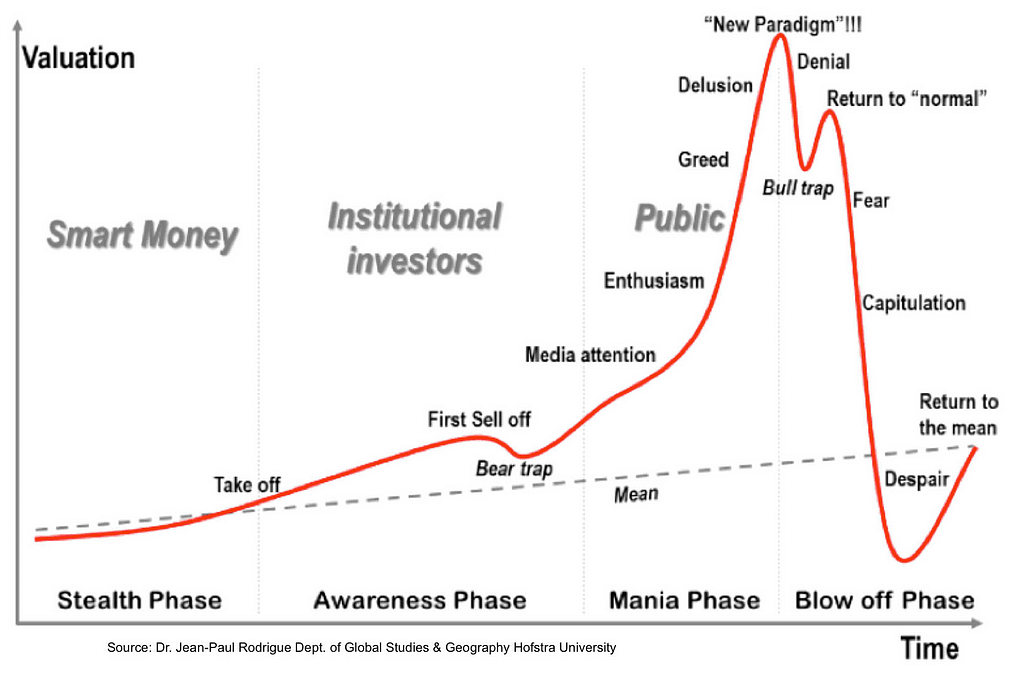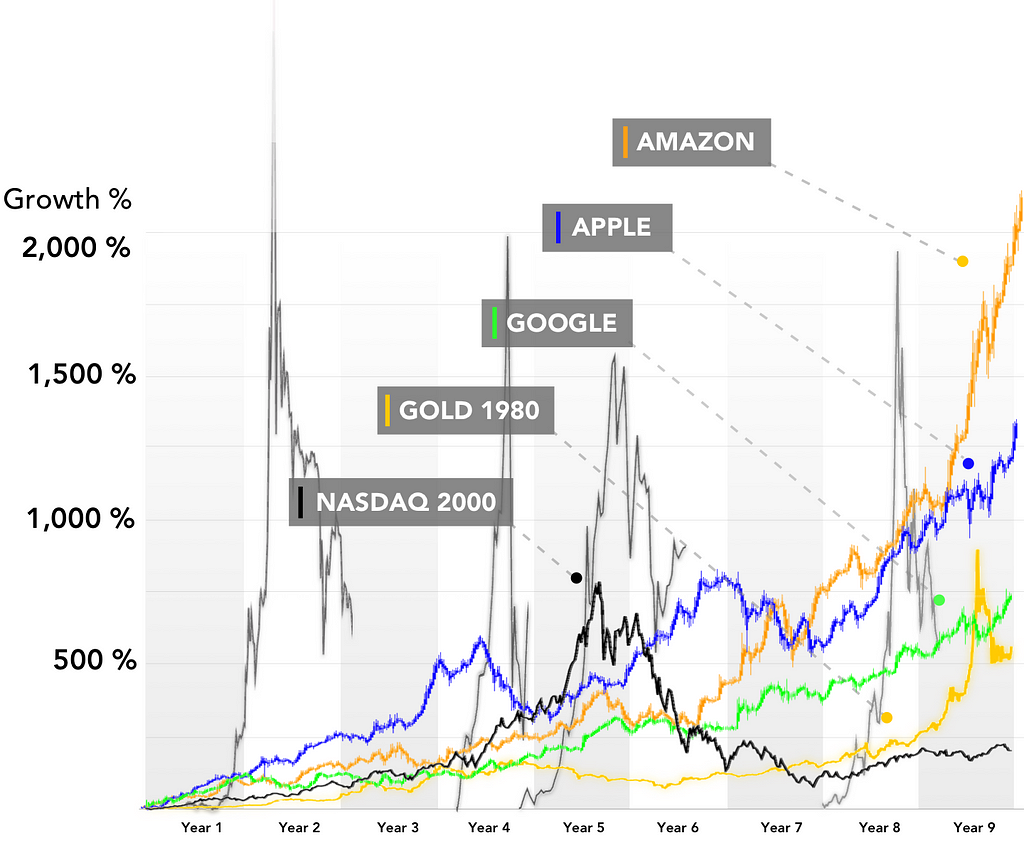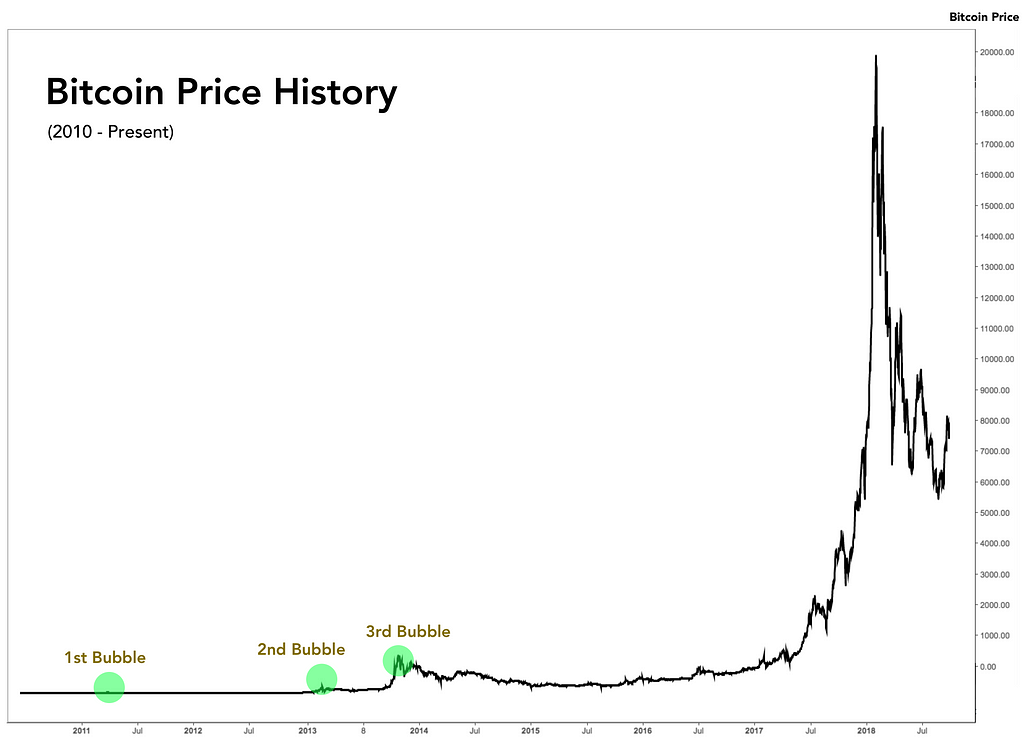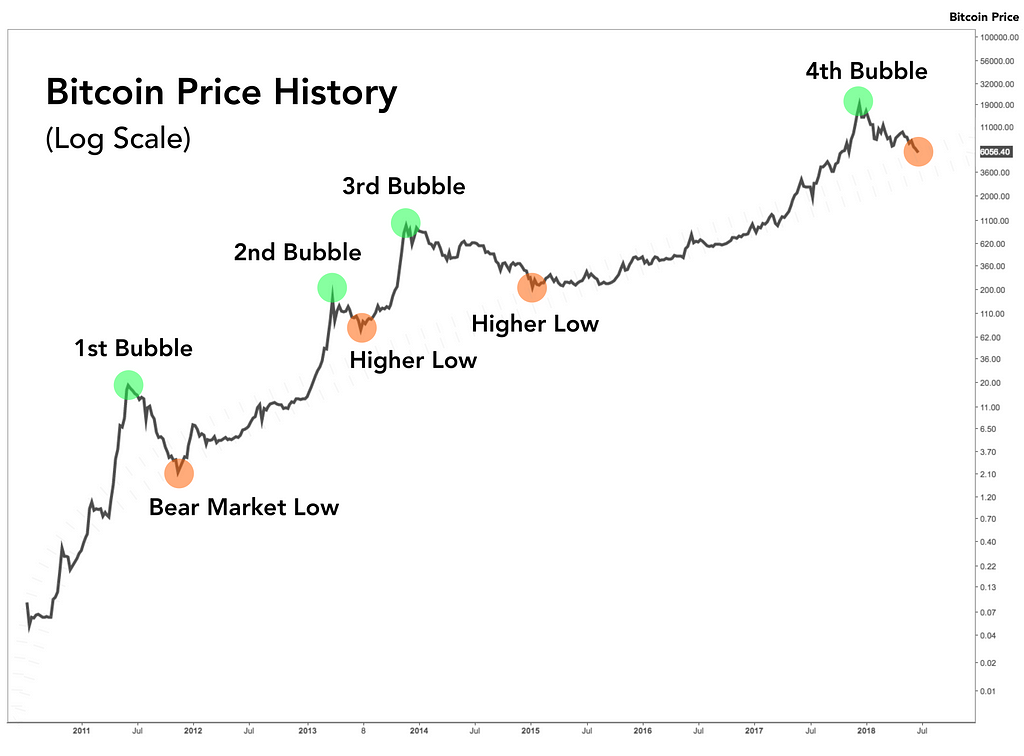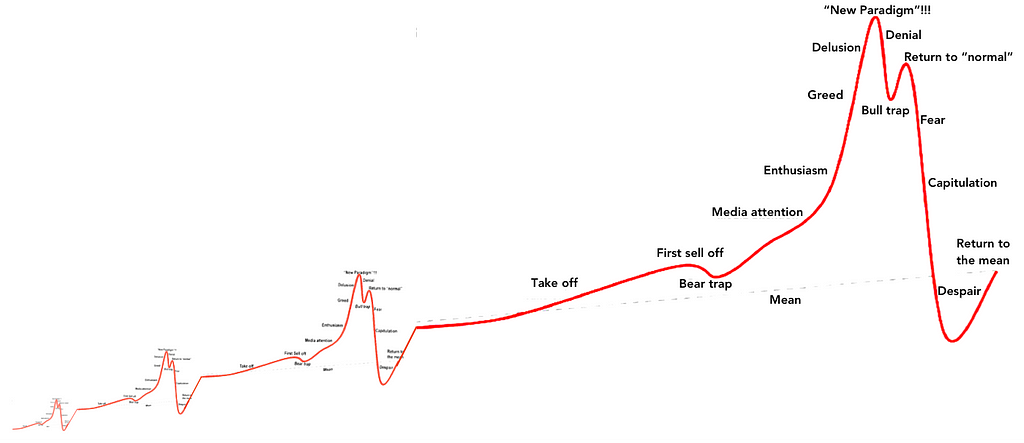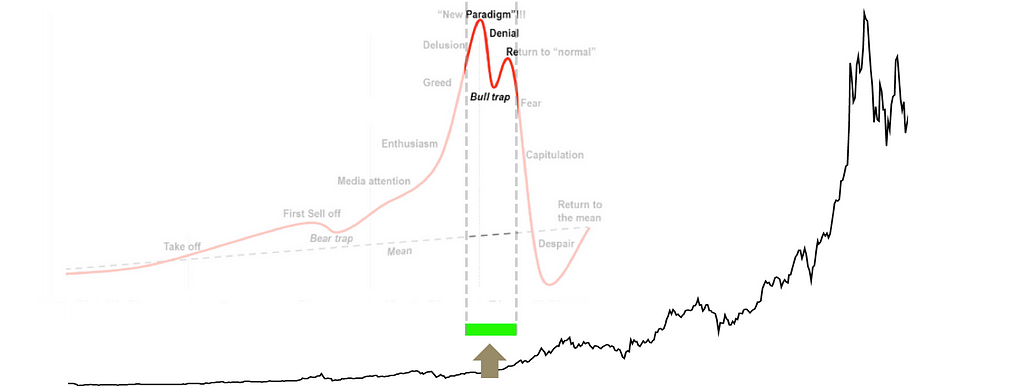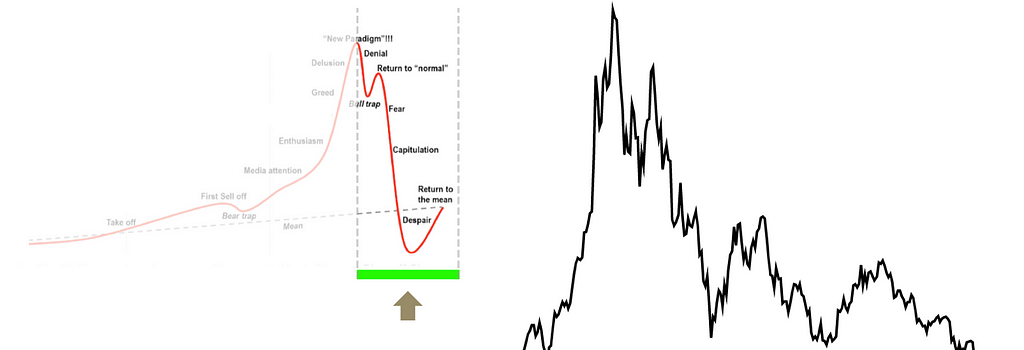Latest news about Bitcoin and all cryptocurrencies. Your daily crypto news habit.

12 months ago I dove head-first down the crypto educational rabbit hole, after seven years as a forex trader.
It’s a steep learning curve. Dozens of market dynamics compete for relevance and attention.
What follows is the single most important thing I learned in 12 months of intense study.
One market dynamic stands above all others as most important for investors and traders to understand.
It’s a pattern — a simple, profound pattern that’s been hiding in plain sight for years.
Faces of Irrational Exuberance
Understanding the pattern begins with this diagram of the lifecycle of financial bubbles.
The red line’s path is not abstract— overlay a chart of almost any famous bubble from the past century and it’ll fit, somewhat dead on, contour-for-contour.
That’s because the underlying pattern directly reflects global market psychology — the invisible hand of mass financial consciousness, at the largest possible scale.
The diagram is useful to investors during speculative bubbles. But in crypto, it’s taken on a whole deeper layer of meaning.
A Brief Financial History of Cryptocurrency
To investors and traders, the history of Bitcoin is the history of four bull runs. (And four crashes).
All four bull runs separately and individually rank among the most dramatic bull markets of the 21st century, across all asset classes. (By growth percentage).
Here’s a bit of context, so you have something to compare it to.
Although price growth percentage was mostly similar across all four bubbles, the price ranges those bull runs covered were very different.
Each successive bull run went exponentially farther than the previous one.
And each post-crash low has been a higher low than the previous one.
(Much higher).
Consecutive higher lows is the definition of an uptrend.
It doesn’t look like an uptrend— it looks flat, until 2017.
That’s because the scale of the most recent bubble is so extreme that you can barely see the first three.
But the same could be said of each previous bubble.
Each went exponentially farther than the one that came before it.
A Special Setting Helps Us See The Pattern
Shifting our charts to logarithmic scale equalizes earlier (exponentially smaller) price trends with more recent (exponentially larger) ones.
We’re able to more clearly spot patterns in price movement that recur cyclically and fractally, independent of scale.
Now we can see it — the four Bitcoin bubbles normalized to scale.
We’ve seen a familiar sequence of events on repeat, ever since Bitcoin’s beginnings in 2010.
Here are Bitcoin’s four bull runs, by the numbers:
The Big Picture
The pattern is straightforward. If anything, one might argue this is the most accurate Bitcoin chart of them all:
The Market Cycle is the Pattern
The pattern guiding Bitcoin’s path is none other than the mirror image of our collective psyche’s relationship with greed and fear.
Since 2010, the lifecycle of financial bubbles has played double-duty as Bitcoin’s market cycle. It is our asset class’s calendar of emotional seasons, and it’s the cryptocurrency market’s Rosetta Stone.
Unpacking the Cycle
Knowing how to operate effectively as a crypto investor or trader is predicated on awareness of one’s position in the cycle.
Currently (at the time of writing) we’re near the end of Bitcoin’s 4th overall cycle, near the bottom of the bear market stage. (This article was published in August 2018).
But identifying one’s position in the cycle is only the first layer of the onion.
Peeling Away the Layers
Each cycle has well-defined seasons, or stages.
Each stage has its own unique set of market dynamics, and poses a different set of emotional and psychological challenges to market participants.
History doesn’t repeat itself, but it does echo and rhyme — like faces on a stack of Russian dolls, each instance of a season inevitably shares its DNA forward cross-cycle with its younger, larger sisters.
Understanding each season’s external market dynamics and internal prevailing psychological terrain is critical to survival and success in this market.
Bitcoin’s Market Cycle
(The Market Cycle of Cryptocurrency as an Asset Class)
The cycle can be classified into four stages:
Stage 1: Accumulation
This stage lasts many months.
Everything is low. Low prices, low volume, low volatility, low expectations.
The previous crash is front of mind to retail investors and traders.
The bottom may be in, but retail investors are traumatized and fear further losses.
Institutional investors, whales and smart money who sold on the way up and shorted on the way down are buying back in before the cycle starts over.
This is the period of greatest opportunity, and ironically (and unsurprisingly) the period when financial media and the public pay the least attention.
Stage 2: Bull Market
A widely-anticipated regulatory fundamental news event acts as catalyst to push price to levels unseen since the early days of the bear market.
Social media sentiment turns bullish. The dominant emotions are confidence, excitement and a sense of great promise.
Price grows incrementally and then retraces, in cycles. Each cycle looks like 3 steps forward, 1–2 steps back, and lasts roughly 3–6 weeks.
Several growth cycles pass, and eventually the old all-time-high is retaken.
People who bought the last top are freed of their burden, reducing sell pressure across the marketplace.
The enthusiasm of price discovery begins to compound. Retail FOMO builds on itself, and financial media fans the flames.
In its first 100 days of price discovery, Bitcoin nearly doubles its old all-time-high.
Not long afterwards, Bitcoin climbs out of its logarithmic channel.
Bitcoin is still moving in cycles, 3 steps forward, 1–2 steps back.
Stage 2, Part 2: Parabola
Without notice, 3 steps forward, 2 steps back is abandoned.
The new normal is 3 steps forward, no steps back.
Bitcoin’s price grows at a parabolic rate from this point forward. Retail FOMO becomes a global phenomenon.
Hip-hop artists endorse ICOs, K-pop bands gush over altcoins.
Crypto-related Google searches are at an all-time-high.
Exchanges are overwhelmed by new account signups and temporarily halt registration. Binance accounts are being sold on craigslist for Monero.
Institutional investors and smart money are scaling out, but are still net long the futures & derivatives markets.
Experts speculate that we’ve reached an inflection point in the cryptocurrency adoption curve, and that price might never again go down.
Retail buyers who sold in frustration after the last crash are now buying back in as price approaches its top.
The timeframe for this last parabolic wave of buying has been amazingly consistent cross-parabola. Historically, all four times it’s lasted 5–7 weeks. (Put that in your back pocket).
Stage 3: Smart Money Takes Profit
The parabolic trend is over. Price crashes violently, about 25%. It tries and fails to retake the all-time-high.
Most retail investors think it’s a healthy correction and aren’t selling.
Profits taken out of Bitcoin are put into altcoins. The altcoin market goes on an exponential parabolic bull run.
Whales and institutional investors have been scaling out of their positions for many weeks, and are now net short the futures & derivatives markets.
This period lasts roughly 6–8 weeks.
Anyone who sells in profit during this period did a great job.
Cryptotwitter is bullish.
Stage 4: Bear Market
Sharp violent drops are followed by weeks of sideways price action.
Retail investors who haven’t been through a full market cycle fail to take profit, and are rekt.
Anyone who bought the top is now at risk of selling the bottom.
Cryptotwitter agonizes over a trendline for months.
Bearish analysts who offer historically accurate price projections are eviscerated in the court of social opinion.
With each new low, a chorus of social media influencers insist that price has just bottomed, that only fools don’t buy the dip, and that alt season is just around the corner.
Bullish relief rallies are met by whales shorting the futures markets, regulatory FUD, high-volume institutional market selling, bagholders exiting at support-turned-resistance, exchange hacks, ICO scandals, last month’s FUD repackaged and rereleased as this month’s FUD, and poorly-explained liquidity dumps somehow loosely and improbably related to Mt. Gox.
The final drop happens suddenly, on high volume, triggering an impulse wave of stoplosses and panic selling. It appears as a long wick on the daily chart.
Many retail investors have just sold the bottom.
Prices that technical analysts have been salivating over for months are available for a handful of hours.
This happens in the middle of the night where you live. Anyone who didn’t place buy orders sleeps through the bottom.
(You can view my buy orders here).
In the end, Bitcoin touches bottom roughly 80% below all-time-highs.
This brings its retrace to roughly the same levels as all previous Bitcoin bear markets.
Accumulation of Capitulation
Our tour of Bitcoin’s market cycle is complete.
Post-capitulation, the retail market will be processing shock and awe.
The low volume weeks and months that follow are a time of opportunity for savvy retail buyers with fiat available on the sidelines.
Bear market buying must be done strategically — I recommend @TheCryptoFam’s excellent tweetstorm on this subject. (Read it here.)
Bitcoin’s Market Cycle is the Cryptocurrency Investor’s North Star
Knowing how to operate effectively as a crypto investor is predicated on awareness of one’s position in the cycle.
Though awareness of one’s position is not a guarantee of profitability. Far from it.
Just like following the north star doesn’t mean you’ll find your way.
But awareness of the star’s presence paints a frame of reference on top of the world, one that makes a life or death difference if you’re adrift at sea.
The metaphor obviously extends to your portfolio in a bear market.
The Fifth Parabola
Whenever we think about the future, it’s important to remember the one and only thing about the future we know for sure.
Which is: we don’t know what’s going to happen.
This forces us to think in probabilities.
Which brings me to a hypothetical question.
Picture a financial instrument: from its inception, it has done one specific thing, and done it cyclically, four times in eight years, at ever-increasing rates of scale.
The question: over the next few years, what’s the highest probability scenario for that asset’s future?
Do you think Bitcoin will stop doing the thing it’s done four times in a row?
It could. That could happen. We have to acknowledge that.
But is that the highest probability scenario?
No. Absent poor fundamentals, an object in motion tends to stay in motion.
And Bitcoin’s fundamentals have literally never been stronger: the New York Stock Exchange announced it will offer cryptocurrency custodial services and a Bitcoin futures contract; Goldman Sachs announced it’s opening an institutional crypto trading desk, and spent $300 million to acquire Poloniex, a top cryptocurrency exchange; Japan, South Korea, Singapore, Switzerland and the UK continue to lead their regions in crypto-friendly regulation; Mastercard just filed a patent for a cryptocurrency fractional reserve system (what could go wrong?); the SEC continues to deliberate on a Bitcoin exchange-traded fund; and the Lightning Network continues to grow, having already made Bitcoin transfers between institutions near-instantaneous.
The highest probability scenario is that the market cycle repeats itself a fifth time.
And that Bitcoin and altcoins go on another exponential parabolic bull run.
(And crash afterwards.)
So Position Yourself For It Now
Now, and in the months that follow. As best you can. While prices are still low.
The two most important skills to learn in preparation for the next cycle:
- Risk management. Success can’t happen without it.
- Learn how to take profits during (and after) a parabolic advance. Become a devoted student of this arcane, insanely relevant skill.
(I am not a financial advisor, and this is not financial advice.)
Follow me on Twitter: @ColeGarnerBTC
The Market Cycle Wears No Clothes was originally published in Hacker Noon on Medium, where people are continuing the conversation by highlighting and responding to this story.
Disclaimer
The views and opinions expressed in this article are solely those of the authors and do not reflect the views of Bitcoin Insider. Every investment and trading move involves risk - this is especially true for cryptocurrencies given their volatility. We strongly advise our readers to conduct their own research when making a decision.
